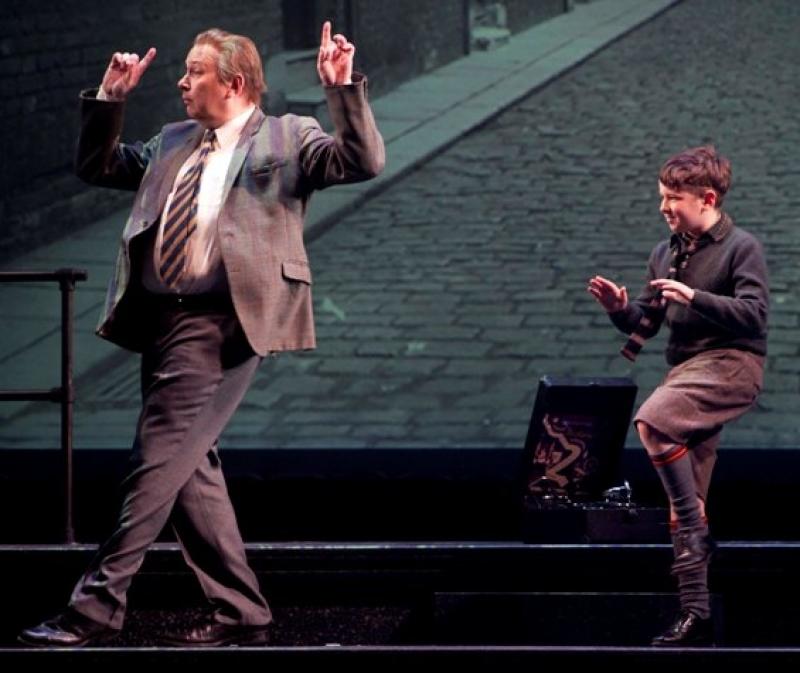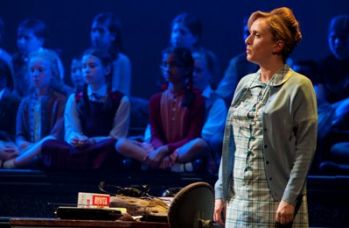That Day We Sang, Opera House, Manchester | reviews, news & interviews
That Day We Sang, Opera House, Manchester
That Day We Sang, Opera House, Manchester
Victoria Wood's play with songs recalls a famous children's choir recording

The creative seed, once planted, can take a long time to germinate and come into bloom – in this case 37 years. For Victoria Wood, 1974 was a seminal year – she turned 21, she won New Faces and she saw a Thames TV documentary about the Manchester Children’s Choir who famously sang Purcell’s "Nymphs and Shepherds" with the Halle under Sir Hamilton Harty in the Free Trade Hall.
When she was asked, being born and bred locally, by Manchester International Festival organisers if she would like to write something Manchester-related, she remembered the choir - and has come up with what she calls “a play with songs”. And, since the old Free Trade Hall is now part of a hotel, it was decided to stage it at the Opera House, the nearest venue a couple of hundred yards down the street. Creditably, another choir of nearly 100 local schoolchildren has been formed to re-enact the big event and the build-up to it. In addition, she attempts to interweave a soft-edged love story about two members of the choir 40 years on.
So, the action flits between 1929, when the children are rehearsing and excitedly getting ready for the big day, and 1969, when Tubby (Vincent Franklin), now an overweight insurance man, and Enid (Jenna Russell, pictured below), a put-upon secretary, meet again on the stage of the Free Trade Hall for a local TV show to share memories of their time in the choir and reflect upon the intervening years.
 Tubby sees the chance to put disappointments behind him and reach out for happiness with Enid, who is locked into a boring job and an every-Tuesday-lunchtime romp with her lustful married boss. It is all played out on a tiered set of a mock-up of the interior of the old Free Trade Hall by designer Lez Brotherston, with images of old Manchester and video clips on a large screen behind and domestic scenes with basic furniture shuffled sparsely into the foreground. This proves to be extremely awkward, particularly towards the end of the show when Tubby and Enid are finalising their relationship in front of the children’s choir assembled for their big day.
Tubby sees the chance to put disappointments behind him and reach out for happiness with Enid, who is locked into a boring job and an every-Tuesday-lunchtime romp with her lustful married boss. It is all played out on a tiered set of a mock-up of the interior of the old Free Trade Hall by designer Lez Brotherston, with images of old Manchester and video clips on a large screen behind and domestic scenes with basic furniture shuffled sparsely into the foreground. This proves to be extremely awkward, particularly towards the end of the show when Tubby and Enid are finalising their relationship in front of the children’s choir assembled for their big day.
After a pretty tedious first half, the show does promise to take off, with two or three numbers worthy of a musical. Tubby meets Enid in the old Piccadilly Gardens for a packed lunch and they imagine that they are Fred and Ginger. Half a dozen other people in the park, including the inevitable policeman, milkman and workman, join in and we get a jolly pastiche of an American musical.
Then Wood, who also directs, provides a vintage song, reminiscent of her unforgettable "Let's Do It" routine, in which buttoned-up Enid let’s herself go and does a fandango with a masked lover. Quite out of character, but great entertainment, almost worthy of VW herself, which is saying something. The junior star of the show is 11-year-old Raif Clarke, making his professional debut, who plays the part of Tubby as a boy, Jimmy Baker. He is perky, sings well, even though there’s a danger of his getting overwhelmed by the orchestra in the pit, and dances a mean Charleston with Tubby.
Finally, of course, after two and a half hours, we come to the singing of "Nymphs and Shepherds" by half the choir, since the children alternate show by show. Sir Hamilton Harty, sensing a possible hit, is given the unlikely comment, “I thought it was worth a punt.” So, what we get is a limited imitation of the original – just over 40 children with the impressive 30-strong Halle Youth Orchestra under Andrew Gourlay. A sort of classical tribute act. However, faithful credit is paid to the woman who coached the original choir and taught the scruffs to sing posh, Gertrude Riall (the excellent Alison Pargeter).
That Day We Sang certainly has flashes of the Wood hallmarks – nostalgia, humour, sentimentality and, above all, community spirit. In the end, it is a well-intentioned, homely, tender Manchester play for a Manchester audience, who lapped it up last night, eager to laugh and even applaud after every scene. But, for once, the Wood magic doesn’t work. Perhaps she set herself the impossible task of mixing archival documentary with an imagined, albeit predictable, midlife relationship which hardly stirs the emotions. The two tales run in parallel without coming together successfully.
- Read theartsdesk Q&A with Victoria Wood: part 1 (Let's Do It) and part 2 (Acorns)
Explore topics
Share this article
Add comment
The future of Arts Journalism
You can stop theartsdesk.com closing!
We urgently need financing to survive. Our fundraising drive has thus far raised £49,000 but we need to reach £100,000 or we will be forced to close. Please contribute here: https://gofund.me/c3f6033d
And if you can forward this information to anyone who might assist, we’d be grateful.

Subscribe to theartsdesk.com
Thank you for continuing to read our work on theartsdesk.com. For unlimited access to every article in its entirety, including our archive of more than 15,000 pieces, we're asking for £5 per month or £40 per year. We feel it's a very good deal, and hope you do too.
To take a subscription now simply click here.
And if you're looking for that extra gift for a friend or family member, why not treat them to a theartsdesk.com gift subscription?
more Theatre
 Tom at the Farm, Edinburgh Fringe 2025 review - desire and disgust
A visually stunning stage re-adaptation of a recent gay classic plunges the audience into blood and earth
Tom at the Farm, Edinburgh Fringe 2025 review - desire and disgust
A visually stunning stage re-adaptation of a recent gay classic plunges the audience into blood and earth
 Works and Days, Edinburgh International Festival 2025 review - jaw-dropping theatrical ambition
Nothing less than the history of human civilisation is the theme of FC Bergman's visually stunning show
Works and Days, Edinburgh International Festival 2025 review - jaw-dropping theatrical ambition
Nothing less than the history of human civilisation is the theme of FC Bergman's visually stunning show
 Every Brilliant Thing, @sohoplace review - return of the comedy about suicide that lifts the spirits
Lenny Henry is the ideal ringmaster for this exercise in audience participation
Every Brilliant Thing, @sohoplace review - return of the comedy about suicide that lifts the spirits
Lenny Henry is the ideal ringmaster for this exercise in audience participation
 Edinburgh Fringe 2025 reviews: The Beautiful Future is Coming / She's Behind You
A deft, epoch-straddling climate six-hander and a celebration (and take-down) of the pantomime dame at the Traverse Theatre
Edinburgh Fringe 2025 reviews: The Beautiful Future is Coming / She's Behind You
A deft, epoch-straddling climate six-hander and a celebration (and take-down) of the pantomime dame at the Traverse Theatre
 Good Night, Oscar, Barbican review - sad story of a Hollywood great's meltdown, with a dazzling turn by Sean Hayes
Oscar Levant is an ideal subject to refresh the debate about media freedom
Good Night, Oscar, Barbican review - sad story of a Hollywood great's meltdown, with a dazzling turn by Sean Hayes
Oscar Levant is an ideal subject to refresh the debate about media freedom
 Edinburgh Fringe 2025 reviews - Monstering the Rocketman by Henry Naylor / Alex Berr
Tabloid excess in the 1980s; gallows humour in reflections on life and death
Edinburgh Fringe 2025 reviews - Monstering the Rocketman by Henry Naylor / Alex Berr
Tabloid excess in the 1980s; gallows humour in reflections on life and death
 Edinburgh Fringe 2025 reviews: Lost Lear / Consumed
Twists in the tail bring revelations in two fine shows at the Traverse Theatre
Edinburgh Fringe 2025 reviews: Lost Lear / Consumed
Twists in the tail bring revelations in two fine shows at the Traverse Theatre
 Make It Happen, Edinburgh International Festival 2025 review - tutting at naughtiness
James Graham's dazzling comedy-drama on the rise and fall of RBS fails to snarl
Make It Happen, Edinburgh International Festival 2025 review - tutting at naughtiness
James Graham's dazzling comedy-drama on the rise and fall of RBS fails to snarl
 Edinburgh Fringe 2025 reviews: I'm Ready To Talk Now / RIFT
An intimate one-to-one encounter and an examination of brotherly love at the Traverse Theatre
Edinburgh Fringe 2025 reviews: I'm Ready To Talk Now / RIFT
An intimate one-to-one encounter and an examination of brotherly love at the Traverse Theatre
 Top Hat, Chichester Festival Theatre review - top spectacle but book tails off
Glitz and glamour in revived dance show based on Fred and Ginger's movie
Top Hat, Chichester Festival Theatre review - top spectacle but book tails off
Glitz and glamour in revived dance show based on Fred and Ginger's movie
 Edinburgh Fringe 2025 reviews: Alright Sunshine / K Mak at the Planetarium / PAINKILLERS
Three early Fringe theatre shows offer blissed-out beats, identity questions and powerful drama
Edinburgh Fringe 2025 reviews: Alright Sunshine / K Mak at the Planetarium / PAINKILLERS
Three early Fringe theatre shows offer blissed-out beats, identity questions and powerful drama
 The Daughter of Time, Charing Cross Theatre review - unfocused version of novel that cleared Richard III
The writer did impressive research but shouldn't have fleshed out Josephine Tey’s story
The Daughter of Time, Charing Cross Theatre review - unfocused version of novel that cleared Richard III
The writer did impressive research but shouldn't have fleshed out Josephine Tey’s story

Comments
...
...